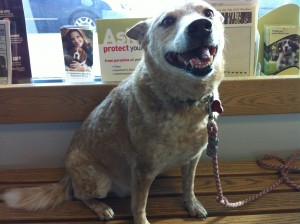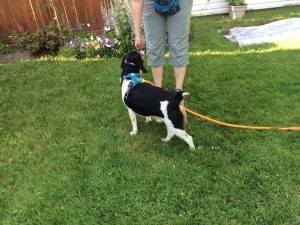I don’t believe that there is such a thing as a perfect reactive dog class. Humans will be humans, dogs will be dogs, and real life training means unexpected situations will arise. However, there are some expected situations we can prepare for to ensure success and progress with our reactive dog clients.
Management Solutions for Teaching a Reactive Dog Class in Imperfect Locations
Not all of us have an ideal environment to host group classes for reactive dogs. The dream is to have a large covered outdoor area that is fenced in to keep loose dogs and curious owners at a distance. This is not the reality for most group classes. However, the demand for classes or semi-private lessons for reactive dogs is high so sometimes you it makes the most sense to provide your clients with an affordable group class.

I have taught classes outside in fields and in small, echoey rooms, but neither is really ideal for reactive dogs due to the chance of off leash dogs coming up in one case and being in close proximity to other dogs in class in the other. Fortunately, all of the dogs in both of these situations can make progress thanks to creative management solutions you can put in place.
As a trainer, your first step is to break down the triggers a dog typically reacts to (in this case other dogs) enough so that when the reactive dog is exposed to it, they don’t have a reaction. In reality, all group classes will set the dogs up to get excited and aroused at first.
Most reactive dogs will get anxious and aroused at the mere thought, smell, or sound of another dog. This means that they don’t actually have to see each other to start the counter conditioning process. Visual barriers are a necessity for every group class with reactive dogs. The dogs will be able to smell and hear, but not see each other. This will reduce their arousal, increase their focus, and allow you to begin the counter conditioning process.
Barriers can be made out of all kinds of materials. You can use PVC pipes to make a frame and then hang fabric from the frame. I have used and recommend getting large panels of insulation and duct taping them together so they can make an L shape and stand alone. The insulation is strong enough to stand by itself and helps reduce noise, but should be stored in a location where dogs cannot get to it and eat it. If you have a larger budget, you can consider making panels out of solid corrugated plastic.
Entering and Leaving Reactive Dog Class
This can sometimes be the most challenging part of reactive dog classes. Everyone has to come through the same doorway to enter and exit the room. There are two approaches you can use to avoid this potentially dangerous situation.
The first is to ask clients to keep their dogs in their cars until you come out and ask them to come in. Most dogs feel safe in their cars. For added precautions, remind your clients to keep their dogs in a covered crate in their cars so the dog does not look out the window and bark at other dogs going by before class. Reactive incidences before class could stunt a dog’s progress during class.
Another idea I got from fellow professional dog trainer, Sarah Fulcher, CDBC, KPA-CTP, is to stagger your group class arrival and departure times for each dog so that no one enters or exits at the same time. Sarah says, “I found that when I had the dogs enter and exit the class room [at set intervals] really helped to keep the classes calm. It also became a valuable exercise for each dog in class – the first dogs in the room had the challenge of staying settled when they could hear or see another dog entering (depending on their progress level, they may or may not have had a visual barrier set up). The dogs that left first had the challenge of possibly walking past another dog, and those staying had to work on being calm while they could hear or see another dog enter or exit. I was always careful to set the dogs up for success, knowing what their triggers and thresholds were, and setting up the entry and exit portions of class so that each dog would be challenged just enough.”
Set Strict Rules for Your Clients

During group classes, don’t be afraid to give your clients strict instructions to ensure their dogs are not set up to fail outside of class. Instead, give them a list of alternative methods to wear their dogs out without having to expose their dogs to triggers. I always recommend that clients avoid dog parks, busy neighborhoods, remind them to block off windows, and other situations that could trigger their dogs to react. Your clients will be overwhelmed with information so break instructions down and make them as specific as possible to set them up for success.
What Your Reactive Dog Clients Do Outside of Class Matters More Than What They Do During It
Sometimes you might be so focused on setting the dog up to be successful that you might forget to set the owner up to be successful, too. As clients become more aware of their dog’s needs, they may take to doing some research for themselves. They may seek out guides, resources, and videos online to learn from. If you have a client like this, consider yourself lucky. They’re demonstrating their commitment to working with their dog, but it can also leave you in a sticky situation.
We all know the internet holds a wealth of knowledge when it comes to dogs. Unfortunately, a lot of the information that is readily available is incorrect, outdated, or untrue to the real science behind dog training. The success of a reactive dog team relies on making sure they stick to your proven plan that revolves around desensitization, counter conditioning, classical conditioning, and some foundation obedience cues. The last thing you want is for the owner to start trying new things they saw online. So what do you do?
You can recommend books, blogs, or Youtube video channels that follow your training approach, but some times that can confuse your client’s even more with terminology or exercises that aren’t part of your program. Ideally, you’d have one place online to send them to so that they could review the exercises you teach in class with more explanations, videos, and graphics to further demonstrate your class’s material.
What is the most challenging thing you find about teaching reactive dog training classes? Comment below!
Sign up below to stay up to date with modern dog training business practices and dog training methods!
Dog Training Business Tips
Receive valuable dog training business tips and resources right in your inbox! Subscribe to The Modern Dog Trainer now by submitting your name and email below. Don’t forget to let us know what you want to learn more about!
[mc4wp_form]



